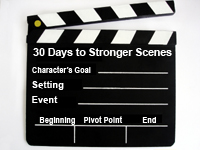Build a Scene List: Then Prune

30 Days to a Stronger Scene Table of Contents
By now, you know what a basic scene is and how to plan a scene. Today we’ll move past the planning to the writing stage. When you write a scene, it helps to break down the actions and emotions into a beat sheet.
Some people use beat sheets to refer to the flow of scenes, but here, I’m using it to refer to the flow of actions and emotions within a single scene.
Beats within a Scene
Here’s an example of beats within a scene I was just working on.
Action Beats/Laurel’s Emotional Beats
- Laurel says she must go/reluctant to leave Jassy
- Jassy gets cloak/staff to escort her/pleased Jassy is coming, shy with Jassy
- Walk through snowy woods/lonely
- A figure appears/fear
- Jassy attacks/please he’s protecting her
- Laurel says, Stop, I know him/surprise
- Laurel introduces Jassy to older man/hesitant, aware of criticism
- Jassy asks for job/hopeful
- Older man looks at Jassy’s hands/encouraged by serious consideration
- Laurel admits she told a secret/scared, glad Jassy is there to protect
In some ways, you might notice, this detailed beat sheet reads like a narrative summary. What’s missing is the detailed development of the scene with full dialogue, action, emotions and thought. Some people even write a full novel with narrative summary, then go back and expand. I feel like that’s what I’ve done on some of my early drafts.
Using a detailed beat sheet for a scene, you can go on and write it easily. The key here is to remember that the beat sheet is a guide for the scene. By developing it early, you’re forced to think about the progression of action and emotion and take into account the physical/emotional settings. However, as I write from a beat sheet, I invariably find ways to introduce more tension. I don’t mind adding, subtracting or shifting the beats as needed when I write. The beat sheet has done it’s job at that point by keeping me focused and I’m willing to let the writing take a tangent course, as long as the focus is getting sharper in the process, instead of blurrier.
2 thoughts on “0”
Comments are closed.